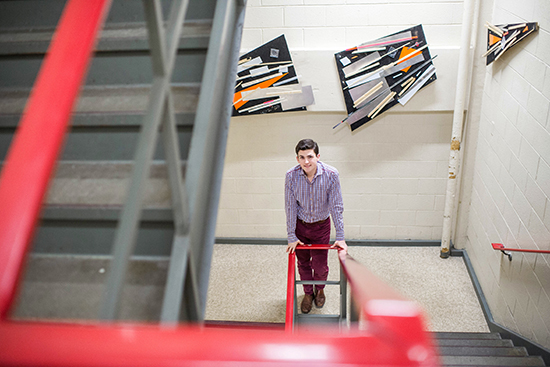CFA Student Artist Turns Stairwells, Hall into Public Art
UROP project spruces up campus

Alexander Golob (CFA’16, CAS’16) created this artwork in the stairwell at the College of General Studies. Photo by Jackie Ricciardi
Think “political science” and you wouldn’t conjure up an image of an art gallery. But a stroll to the third floor of 232 Bay State Road, home to the College of Arts & Sciences poli-sci department, is a minicourse in art appreciation. On the wall hangs a carved reproduction of the University seal, its waterfront view of Boston depicting what Puritan John Winthrop celebrated as the “city upon a hill.” In a bit of artistic license, a peace dove is affixed to the seal, which also is surrounded by multicolored wooden rectangles.
Installed last August, the artwork and two others at the rear of the College of General Studies are the work of Alexander Golob (CFA’16, CAS’16), inspired by his freshman amblings across campus three years ago. At the time, he encountered what he considered a visual desert, devoid of appealing public art.
“I kept on imagining the concrete filled with vibrant color and dynamic forms,” Golob recalls, “spaces that, instead of just funneling people through them, lifted them up.” Shortly after those initial walks, and with the parking lot wall at the College of Fine Arts as his canvas, Golob picked up a paintbrush. With help from more than 80 volunteers, he painted the colorful cityscape mural you see there now.
“The response from everybody was immediate,” Golob says: student groups used the mural as a performance backdrop, the school scheduled events in front of it, and “there were no shortage of selfies.” Encouraged, he undertook last summer to fill in some of BU’s aesthetic blanks with public artworks through the Undergraduate Research Opportunities Program, which matches students with faculty mentors across the University and provides funding for projects. CGS and the political science department are the beneficiaries. The piece on the CGS second-floor landing is a collage of geometric shapes of wood, metal, glass, and plastic. On the landing of the third floor are photos of young people mugging for the camera with various captions—“CGS Fam,” “Arrrrrrt,” “Boston Marathon April 20, 2015.”
Ironically, the CAS history of art and architecture department opted not to accept an artwork. Golob knew from the outset that creating an appropriate artwork there would be challenging. “I really enjoyed working with the department,” he says. “As a space that focuses on the studies of art and architecture, there were many ideas that needed to be weighed and debated.…I believe that the experience was incredibly helpful for both myself, the department, and future artists.”
Indeed, a key research goal of this undergraduate research was discovering the steps necessary to secure agreement from public art hosts: “initiating creative dialogue with clients, developing flexible outcome goals, arriving at a solution that both expresses the need of the client and the unique qualities of the artist,” says Golob’s UROP advisor Hugh O’Donnell, a CFA professor of art.
“One of the great features of working with Alexander is that he incorporates the whole community in designing the project,” says Natalie McKnight, dean of CGS. “He held several meetings with students, faculty, and staff at CGS to elicit and refine their ideas about the nature of the space where we wanted the art to be installed and what they would like to do with it.” Both projects “bring a lot of color, energy, and interest to the back stairwell,” McKnight says, so much so that she’s hoping Golob might spruce up two other spaces in the near future. “Students and faculty have both commented on how much they enjoy the art.”
That collaboration is “one of the reasons I love site-specific art so much,” Golob says. “In order to make something that can positively impact and transform a public space, the artist needs to negotiate among all of the disparate stakeholders in the space.…Doing something new is always difficult. When it comes to larger creative projects that require time, logistics, and community buy-in, there is inertia.…I am trying to show what steps work and what steps don’t.”
Comments & Discussion
Boston University moderates comments to facilitate an informed, substantive, civil conversation. Abusive, profane, self-promotional, misleading, incoherent or off-topic comments will be rejected. Moderators are staffed during regular business hours (EST) and can only accept comments written in English. Statistics or facts must include a citation or a link to the citation.